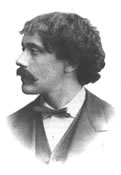Pablo de SARASATE (1844-1908)
The Spanish violonist and composer PABLO DE SARASATE was born in Pamplona, Spain and began studying the violin at the age of five with his father. He gave his first concert when he was eight and received a Stradivari violin from Quessn Isabella of Spain when he was ten. Having been received with enthusiasm by his early audiences, the boy was sponsored by a wealthy patron so his parents could afford to take him to Madrid for further study. It was not long after his arrival that Pablo became a favourite performer at the court of Queen Isabell II. When Pablo was 12, his mother decided to take him to Paris to study with the famous teacher Jean Alard at the Conservatory of Music. There he easily won the First Prize for violonists when he was 17.
 At the beginning of his career, Sarasate performed opera fantasies, most notably the Carmen Fantasy and other pieces he composed. Most of his compositions have a Spanish flavour, and it was chiefly because of Sarasate that Spanish music was very popular among the European composers of that day. Many important violin works were dedicated to him, including Bruch’s G minor Violin Concerto and Scottish Fantasy, Saint-Saens’s First and Third Violin Concertos and Introduction and Rondo Capriccioso, Wieniawski’s Second Violin Concerto and Lalo’s First Violin Concerto and Symphonie Espagnole.
At the beginning of his career, Sarasate performed opera fantasies, most notably the Carmen Fantasy and other pieces he composed. Most of his compositions have a Spanish flavour, and it was chiefly because of Sarasate that Spanish music was very popular among the European composers of that day. Many important violin works were dedicated to him, including Bruch’s G minor Violin Concerto and Scottish Fantasy, Saint-Saens’s First and Third Violin Concertos and Introduction and Rondo Capriccioso, Wieniawski’s Second Violin Concerto and Lalo’s First Violin Concerto and Symphonie Espagnole.
Sarasate’s four volumes of Spanish dances for violin and piano have been favourites for generations, and his Zigeunerweisen for Violin and Orchestra is a concert standard. When he died in 1908, he left his earthly goods to the city of Pamplona, Spain, where today there is a Sarasate museum.
Sarasate used a very slow and wide vibrato, which almost sounded like no vibrato. He was fond of using harmonics and employed a graceful „staccato volant“ or „flying staccato“. This bowing uses many notes per bow (usualy upbow), while the bow leaves the string slightly after or before each note. It is sometimes played near the extreme tip of the bow. His playing was called perfectly „clean“ and he reportedly played with a small tone and unforced bowing, and rarely louder than mezzo forte. He was known for creating wonderful colours and had small hands, not well suited for Paganini’s or Ernst’s difficult pieces.

